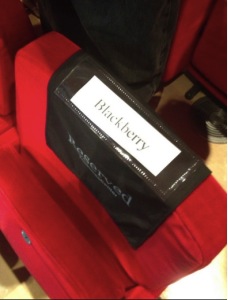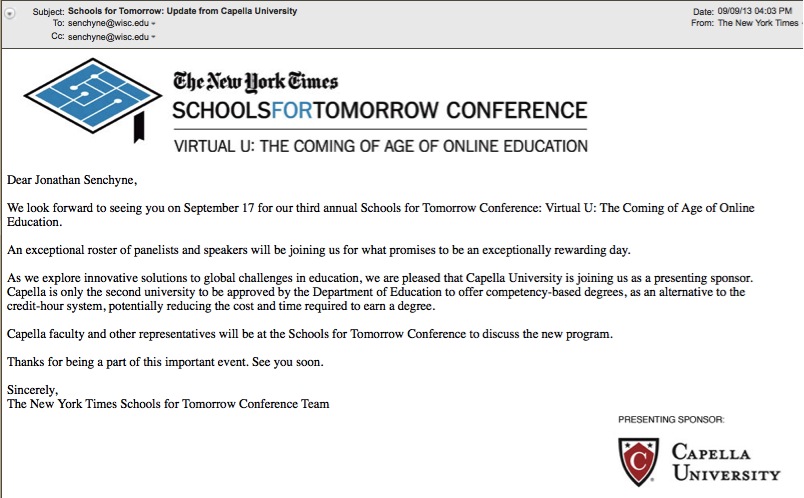You have /5 articles left.
Sign up for a free account or log in.
Last week, Nicholas Kristof revived the old canard that academics have removed themselves from the public sphere through obscure prose and interests. Among the problems we might identify in Kristof’s essay -- there are, obviously, many -- is the irony of a writer with the resources of The New York Times supporting him chiding the rest of us for not writing in outlets such as The New York Times.
But who gets to write in The New York Times -- and to whom is The New York Times accessible? If we’re talking about accessibility and insularity, it’s worth looking at The New York Times’s own content generation cycle and the relationship between press junkets and patronage.
So, instead of confusing intellectual meritocracy with access to outlets, let’s look at how The New York Times itself generates content about something that matters greatly to professors: higher education.
In September 2013, I attended The New York Times Schools for Tomorrow Conference (theme: "Virtual U: The Coming Age of Online Education") held at the conference center of the Times’s new building (video archive streaming here).
What I learned there -- besides how weird corporate-sponsored conferences are, right down to commercials they looped on screens between talks -- is that there is a system of content generation that feeds thinkpieces and thinkfluencers with greater speed and sound bite concision than most professors can offer.
It’s important to note that the only professors on stage at this conference on the future of higher education had left teaching and research as faculty for academic upper administration or to launch their own MOOC companies. While Kristof might see this lack of platform as more evidence of academic self-cloistering, I see it for the closed system that it is: “influence” comes mainly from those who might be in the position to take out full-page ads in the Times.
 I saw the Schools for Tomorrow conference advertised in the Times’ Sunday Magazine, and looked into registration online. It cost $795 for a one-day event. For reference, I just registered for a four-day conference in my humanities field for $150.
I saw the Schools for Tomorrow conference advertised in the Times’ Sunday Magazine, and looked into registration online. It cost $795 for a one-day event. For reference, I just registered for a four-day conference in my humanities field for $150.
I wrote to the Schools for Tomorrow registration office and asked if they could lower the cost for actual professors, bringing it in line with typical registration fees between $75 and $200. They said they could bring it down to $495. I found some institutional money for online teaching development and paid the “reduced” fee.
The $495 did not, however, guarantee me a seat when I got to the conference. The mid-three figures is a lot for humanities faculty and their limited (if existent) travel support, but in this world it just got me through the first door. It turned out that the plenary talk by Sal Khan (of Khan Academy) on globalizing access to education was overbooked, so while corporate sponsors like Bank of America and Blackberry enjoyed reserved seats in the auditorium, a lot of self- or university-sponsored folks like myself ended up watching on screens in the basement.
This was the first lesson in sponsored access to influence and content creation. Since Khan’s talk led into the panel discussion “Has the University as an Institution Had Its Day?” a lot of professors sat out the Q&A in the cheap seats. Not even, really. We were in a different arena altogether.
This, the second lesson. I thought that going to this space of industry, academic and journalistic overlap would allow me to contribute to the conversation outside the so-called cloister. But this was a sales pitch and I was a potential buyer. A parade of highly polished representatives from government, finance, education administration, The New York Times, nonprofit policy tanks, and private-sector business came on stage in various combinations to deliver pitches.
These weren’t conversations; these weren’t arguments. Mainly, these were rehearsed pitches for products, policies, and industries in which presenters had considerable financial or political stake. Some featured speakers, like former Senator Bob Kerrey, had a foot in several categories: he was in the Senate, he had been president of the New School, and he is now starting a for-profit university.
At various points it became clear that the speakers were used to talking to one another “on the circuit” as one said to another, suggesting that they’d been on the online education junket a lot together that year. And some cycle back through the Times meetings. Having missed Sal Khan at the education conference, I could have caught him the next month at the DealBook business conference.
The third lesson of the conference, however, came when I picked up my New York Times at home. The November 1 "Education Life" section titled “The Disrupters” is almost entirely drawn from or inspired by the conference. One conference reviewer quipped that “so many Times newsroom staff members are participating in the conference, they might not be able to put out the paper on Wednesday.”
To the contrary, such events seem to be built into their content generation strategy. “The Disrupters’ ” lead article, "Innovation Imperative: Change Everything, Online Education as an Agent of Transformation" was written by Michael Horn and Clayton M. Christensen. Both hail from the non-university-affiliated Clayton Christensen Institute for Disruptive Innovation. The latter is a business professor at Harvard and the former was a panelist at the conference. Here's Horn’s bio from the conference webpage. He did a 25-minute one-on-one with David Leonhardt, the Times's Washington bureau chief, advocating “The Disruption of Higher Education.”
According to his bio, Horn studied for an M.B.A. at Harvard (presumably with his co-author Christensen), then gained a platform as an educational innovation consultant at Arizona State, the editorship of a “journal of opinion and research about education policy,” and invitations to testify on issues relating to education. He does so not from a university, but from an institute that operates in the world between academia and lobbying. He does not balance his time between teaching, service, and peer-reviewed research and publishing. Yet he is a recognized authority on higher education according to the Times’s invitation. And then his work is immediately funneled into and amplified by featured space in the Sunday Times.
Even if the Times itself might be forgiven for seeking out breathless think tankers over professors who lack their own Center for Thinkfluencer Excellence, we might be more critical of the blurry line between content and advertisement.
Elsewhere in the issue you’ll find Bob Kerrey’s Minerva University, a for-profit liberal arts venture, featured prominently. It is mentioned in the Horn article, and is the focus of this article on “affordable elitism.” And then there’s major conference sponsor, Capella University. Their “credit for competencies, not credit hours” model is the subject of this article. It was also a major topic of conversation at the conference, discussed at length by Capella University's president, Scott Kinney. Days before the conference, every registrant received an email promoting Capella and bearing their logo.
How much money did Capella pay for this multiplatform marketing strategy? And where did their marketing end and the ideas at the conference begin? They were in the email of all registrants. Their logo was all over the conference and in full color on the back page of the Times Sunday Magazine. Policy changes crucial to their success were discussed favorably at a conference with Education Secretary Arne Duncan in attendance, and they got an article focusing on them in the Times just below an editorial praising their sort of educational “disruption.”
When Kristof's article began raising questions about professors’ ideas and public influence, I was reminded of the way influence moved from the $795/$495 per person corporate-sponsored conference to the pages of the newspaper of record.
Professors, we need you! Who, then, is the “we”? As lots of people have pointed out, if the “we” is the American public, then you’ve already got us as teachers, popular and specialist writers, activists and more.
If the “we” is pageview ad-metric revenue-hungry online content providers and writers, then that’s another question. Do you really want us? And if we come to you, how much will it cost to get in?









